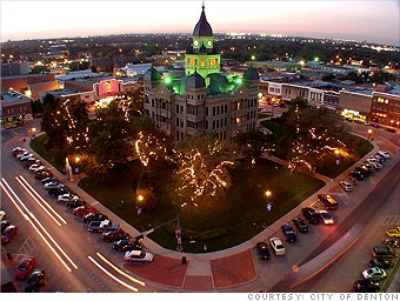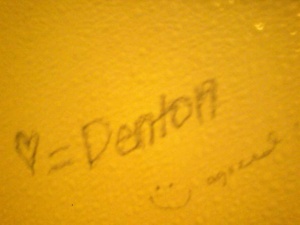 The Square is an important gathering place for Dentonites.
The Square is an important gathering place for Dentonites.
Were you looking for Denton County? Or maybe you were looking for one of the other Dentons.
The City of Denton (referred to as Denton, Little D and at least once referenced as the Athens of the South) is the county seat of Denton County. Residents of Denton are called Dentonites (occasionally Dentonians, though this is generally considered pretty weird). Its population was 121,123 according to the 2012 U.S. Census Bureau estimate, making it the eleventh largest city in the Dallas/Fort Worth (DFW) Metroplex. Geographically, it is 40 miles south of the Oklahoma–Texas border, 40 miles northwest of Dallas, 40 miles northeast of Fort Worth, and 37 miles west of Plano.
Denton is home to two state universities, the University of North Texas, the largest university in North Texas, and Texas Woman's University, a historically single-sex college, completely co-ed since 1994. Altogether, about 48,000 students participate in courses at the two universities. ( About 36,000 students at UNT, and roughly 12,000 students at TWU.) The presence of these two large universities leads to Denton being characterized frequently as a college town.
A Texas land grant led to the formation of Denton County in 1846, and the city in 1857. Both were named after pioneer and Texas militia captain John B. Denton. The establishment of the two universities helped distinguish the city from neighboring regions. As a result, educational services, as well as retail trade, play the largest roles in the Denton's economy. The town is known for its active music life, which Paste magazine named America's "Best Music Scene" in 2008. The annual North Texas State Fair and Rodeo and the Denton Arts and Jazz Festival are major events that attract over 300,000 people. Denton has seen considerable growth in recent years and in 2006, Money magazine named Denton No. 58 out of the "Top 100 Best Places to Live in America."
That means we're really cool.
History
For more information see the History of Denton main page.
Also see Timeline of Denton
The formation of Denton is closely tied with that of Denton County. Unlike other neighboring cities in North Texas, there is no record of a large native-American population in the area before 1800. European settlement began in mid-1800s when William S. Peters of Kentucky obtained a land grant from the Texas Congress and named it Peters Colony. After initial settlement in the southeast area in 1843, the Texas legislature voted to form Denton County in 1846. Residents chose two different county seats (Pinckneyville and Alton) before voting on Denton as the final county seat in 1857. Both the county and the town were named in honor of John B. Denton, a preacher and lawyer, who was killed in a 1841 battle led by General Edward H. Tarrant against Keechi Indians. A commission composed of Otis G. Welch and others laid out the city and named the first streets in 1857. Denton was not incorporated until 1866; its first mayor was J.B. Sawyer.
The city expanded greatly as it became a strong agricultural trade center and manufacturing destination for mills and cottage industries. The creation of the Texas and Pacific Railway in 1881 gave Denton its first rail connection, and brought an influx of people to the area. Despite this, it did not develop into a strong manufacturing location, relying instead on agricultural workforces.
Denton became a college town when North Texas Normal College (now the University of North Texas) was established in 1890 and the Girls' Industrial College (now Texas Woman's University) in 1903. As the universities increased in size, their impact on Denton's economy and culture also grew.  A local resident's tattoo, in which his nipple acts as a marker for Denton.
A local resident's tattoo, in which his nipple acts as a marker for Denton.
At one time considered the cultural center of Denton, the area surrounding Fry Street was home to a group of shops, music venues, and restaurants. Many of the buildings were originally constructed in the 1920s. From 1914 to 1959, Denton was governed under a mayor-city commission form of government, but a new charter adopted in the latter year switched the city to a council-manager form of government.
In 1954 the regional office of the Federal Civil Defense Administration moved from Dallas to Denton, and a few years later a large underground shelter was completed. For a time it was the only FCDA underground shelter and was designated as the place from which the president of the United States and other federal officials would direct the country in case of attack. The FCDA shelter would later become the headquarters of FEMA Region VI.
Denton grew rapidly from a population of 26,844 in 1960, to 48,063 in 1980. Its proximity to the Dallas-Fort Worth Metroplex, directly connected via Interstate 35, played a major role in this growth. The opening of the DFW International Airport in 1974 led to a small spurt in population. Older manufacturing firms with significant employment such as Moore's Business Forms and Morrison Milling Company were joined by heavy manufacturing companies like Victor Equipment Company in the mid-1960s and Peterbilt in 1980, and led to increased local employment. The population jumped from 66,270 in 1990 to 80,537 in 2000.
Fry Street Demolition
In May 2006, the 100-block of the historic Fry Street area was purchased by United Equities, a Houston-based real estate company, which announced that several of the historic buildings would be demolished to accommodate a new mixed-use center. Known as Fry Street Village, the center would include retail stores and restaurants. The proposal polarized the city, and a grass roots effort by the non-profit organization Save Fry Street began soon thereafter. It sought to preserve Fry Street as a historic and cultural icon for the city. Development stalled in 2008, when the city council rejected a permit that would allow for the construction of a drive-thru CVS Pharmacy, the anchor for the project.
Quakertown
For full article see: Quakertown
Quakertown was originally a settlement of African-Americans in Denton, named after the Quakers who had helped in the Underground Railroad. Quakertown was the center of a number of African-American communities, and contained churches, a school, businesses, a doctor and a funeral home. When Texas Woman's University was built in close proximity, there was an election over whether or not to build a park in the location of Quakertown. The election was won in favor of the park, and the African-American residents were forced to leave.
Geography of Denton
 UNT is in the center, TWU towers visible in background.Geographically, Denton is located on the northern edge of the Dallas-Fort Worth metropolitan area at the intersection of I-35 and U.S. Highways 380, 377 and 77. It is also here that I-35 splits into I-35E and I-35W to reach Dallas and Fort Worth, respectively. These three cities form the area known as the "Golden Triangle of North Texas." Lake Lewisville, a fishing destination named the "Urban Bass Fishing Capital of Texas", is located 15 miles south of the city.
UNT is in the center, TWU towers visible in background.Geographically, Denton is located on the northern edge of the Dallas-Fort Worth metropolitan area at the intersection of I-35 and U.S. Highways 380, 377 and 77. It is also here that I-35 splits into I-35E and I-35W to reach Dallas and Fort Worth, respectively. These three cities form the area known as the "Golden Triangle of North Texas." Lake Lewisville, a fishing destination named the "Urban Bass Fishing Capital of Texas", is located 15 miles south of the city.
According to the United States Census Bureau, the city has a total area of 62.3 square miles, of which, 61.5 square miles of it is land and 0.8 square miles of it (1.33%) is water. The land lies in the northeast edge of the Bend Arch-Fort Worth Basin, which is characterized by flat terrain. Elevation ranges from 500 to 900 feet. Underneath the city is a portion of the Barnett Shale, a geological formation believed to contain large quantities of natural gas.
Climate
With its hot, humid summers and cool winters, the climate of Denton is characterized as humid subtropical. Dry winds reach the area in the summer and can bring temperatures to 100 °F, although the average summer temperature is in the mid-90s. The coolest month is January with temperatures dropping down to an average minimum of 32 °F. Average snowfall in Denton is similar to the Dallas-Fort Worth average of 2.4 inches per year, though a notable extreme happened on Snowmageddon. Denton lies on the bottom end of the Tornado Alley area. Although tornadoes rarely form, tornado watches are issued by the National Weather Service. Flash floods and severe thunderstorms are frequent occurrences during the months of spring.
The city's all-time high temperature is 113 °F, recorded in 1954, while the all-time recorded low is −3 °F. Denton receives approximately 37.7 inches of rain per year.
Things to Do
 Graffiti at Banter.
Graffiti at Banter.
There are plenty of things to do in Denton, not all of which require alcohol consumption.
Alcohol is very popular in Denton though.
Other people get exercise, even going so far as to ride bicycles.
Some people edit DentonWiki for fun.
Others just go to see moving pictures, or see live stage plays at The Campus Theatre, or read books at the libraries.
Music in Denton
The Denton music scene has been noted nationally. Denton is the origin of acts such as Sarah Jaffe, Brave Combo, and Bowling for Soup.
Universities
For over a hundred years Denton has been the home to two prominent Texas Universities, the University of North Texas and Texas Woman's University. For this reason, Denton is often characterized as a college town.
Buildings
There are quite a few buildings.
Organizations
For more information see Organizations (main page).
Dentonites like to organize, from the Mormons to the bisexuals.
Denton in Popular Culture
See Denton in Popular Culture for more
- The City of Denton is where Brad proposes to Janet in "The Rocky Horror Picture Show", and is also called "The Home of Happiness" on a billboard in the first scene of the movie in the churchyard. For a brief time in the early 1990's, a billboard was in place along I-35 north of the city that said the same thing, erected each year before Halloween.
- The American indie rock band, The Mountain Goats have a song titled "The Best Ever Death Metal Band in Denton" on their album "All Hail West Texas."
- White Lilacs, a novel written by Carolyn Meyer, depicts the removal and struggle of the residents of Quakertown, though all character names and other specifics have been changed.
- The courthouse seen in the 1982 Dolly Parton film Best Little Whorehouse in Texas is often mistaken for Denton's Courthouse-on-the-Square, but is actually fact Lavaca County Courthouse in Hallettsville, Texas. Both structures have similar architecture.



